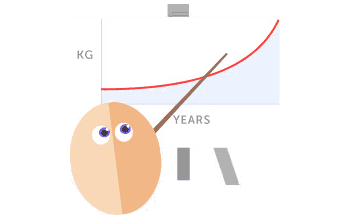I have been investigating the research into the variation in energy expenditure, thyroid function, leptin etc between people which might point to sources of variation in weight and weight loss and found a few interesting titbits:
Basically, some of us are more efficient in moving than others and this causes most of the variation in TDEE. (From http://jn.nutrition.org/content/129/10/1765.long)
Differences in the amount of walking around only accounted for around half of the variation in physical activity energy expenditure (PAEE) seen in women (from http://www.ncbi.nlm.nih.gov/pubmed/22963352)
Men with apparently normal thyroid function showed differences in body weight, fat mass and the appetite controlling hormone, leptin, that could be accounted for by differences in thyroid hormone levels (from http://www.ncbi.nlm.nih.gov/pubmed/22956557)
However, by contrast in a study aiming to determine predictors of weight loss in obese men participating in a 2-year behaviour modification programme:
So in this group, leptin was the baddy not thyroid hormone (from http://www.ncbi.nlm.nih.gov/pubmed/11086640)
Lastly we have the conclusions of this interesting study on habitual dieters:
From http://ajcn.nutrition.org/content/71/6/1413.long
The DLW [doubly labelled water] method has also been used to demonstrate that the interindividual differences in energy expenditure associated with physical activity are larger than those for RMR or the thermic effect of meals (TEM) and thus more likely to lead to major deficits or surfeits in energy balance.
Basically, some of us are more efficient in moving than others and this causes most of the variation in TDEE. (From http://jn.nutrition.org/content/129/10/1765.long)
Twenty men and 34 women (20-36 years of age) provided complete anthropometric, accelerometer, resting metabolic rate (RMR), and DLW data. TEE and PAEE were determined for the same week that accelerometers were worn during waking hours. Accelerometer data included mean steps per day, peak 30-min cadence (average steps per minute for the highest 30 min of the day), and time spent in each incremental cadence band: 0 (nonmovement), 1-19 (incidental movement), 20-39 (sporadic movement), 40-59 (purposeful steps), 60-79 (slow walking), 80-99 (medium walking), 100-119 (brisk walking), and 120+ steps·min(-1) (indicative of all faster ambulatory activities). Regression analyses were employed to develop sex-specific equations for predicting TEE and PAEE. The final model predicting TEE included body weight, steps per day, and time in incremental cadence bands and explained 79% (men) and 65% (women) of the variability. The final model predicting PAEE included peak 30-min cadence, steps per day, and time in cadence bands and explained 76% (men) and 46% (women) of the variability. Time in cadence bands alone explained 39%-73% of the variability in TEE and 30%-63% of the variability in PAEE. Prediction models were stronger for men than for women.
Differences in the amount of walking around only accounted for around half of the variation in physical activity energy expenditure (PAEE) seen in women (from http://www.ncbi.nlm.nih.gov/pubmed/22963352)
BMI was positively associated with (F)T(3) (P<0.0001). Whole body fat mass displayed positive associations with TT(3) and with (F)T(4) and TBG (P≤0.0006). Positive associations were further observed between leptin and (F)T(3), TT(4), and TBG (P≤0.0002). Inverse associations between lean mass and muscle cross-sectional area and (F)T(3), (F)T(4), and TBG were observed (P≤0.0003). Higher levels of (F)T(3) and TBG were associated with lower insulin sensitivity, assessed by homeostatic model assessment of insulin resistance (IR; P≤0.0001). No associations between TSH and body composition or metabolic parameters were seen.
CONCLUSION:
We show that a less favorable body composition (with higher fat and lower muscle mass and accompanying higher leptin concentrations) and IR are associated with higher thyroid hormone levels in healthy young men with well characterized euthyroidism.
Men with apparently normal thyroid function showed differences in body weight, fat mass and the appetite controlling hormone, leptin, that could be accounted for by differences in thyroid hormone levels (from http://www.ncbi.nlm.nih.gov/pubmed/22956557)
However, by contrast in a study aiming to determine predictors of weight loss in obese men participating in a 2-year behaviour modification programme:
At baseline, there were significant correlations between plasma leptin and body mass index (BMI), fat-free mass (FFM) and insulin resistance. Median weight loss over 2 years was 4.9 kg (range, -27.2 to +11.9). Baseline serum leptin concentrations adjusted for BMI (leptin/BMI ratio) were significantly correlated with 2-year weight change (r = 0.34, P = 0.04). A subset of seven of the 44 men gained weight over the 2 years. These 'gainers' differed significantly in initial leptin/BMI ratio (0.62 +/- 0.07) compared with the 37 'losers' (0.42 +/- 0.03, P < 0.05). In a multiple regression model, baseline leptin, insulin and age predicted 22% of the variance in weight change with no additional significant contribution from BMI, FFM, waist:hip ratio, thyroid function tests or energy intake. There was a strong correlation between the change in leptin concentrations and the change in insulin resistance from baseline to 2-year follow-up (r = 0.54; P < 0.001).
CONCLUSION:
Baseline plasma leptin concentrations predicted long-term weight loss. Inappropriate leptin secretion or disposal, corrected for BMI, was associated with failure to maintain weight loss in obese men in a behaviour modification weight loss programme.
So in this group, leptin was the baddy not thyroid hormone (from http://www.ncbi.nlm.nih.gov/pubmed/11086640)
Lastly we have the conclusions of this interesting study on habitual dieters:
The results of the present study indicated differences in metabolic variables between the 2 groups of female chronic dieters; body-composition variables, particularly LBM, best predicted REE. The results also indicated that a normal REE was associated with insulin resistance. Insulin resistance has been shown to correlate positively with a high ratio of abdominal to gluteal fat mass, which was shown in women in the NREE group. Differences in leptin were likely due to normal diurnal variations rather than to the influence of food consumption or REE. The higher T4 and rT3 values in the NREE group support the positive association between thyroid production and metabolic rate; however, this difference has been shown mainly under conditions of energy restriction, which was not the case for the NREE group. More research is required to elucidate the complex interactions of insulin, leptin, and thyroid hormones in energy metabolism. The LREE group had higher dietary restraint than did the NREE group. This may partly explain the lower REE of the LREE group because dietary restraint has been shown to the reduce metabolic rate.
The female chronic dieters in the LREE group in the present study had a low LBM, low metabolic hormone concentrations, and high dietary restraint. Health promotion programs that emphasize regular physical activity and normalized eating behaviors (ie, a healthy diet) may be beneficial for this group.
From http://ajcn.nutrition.org/content/71/6/1413.long






